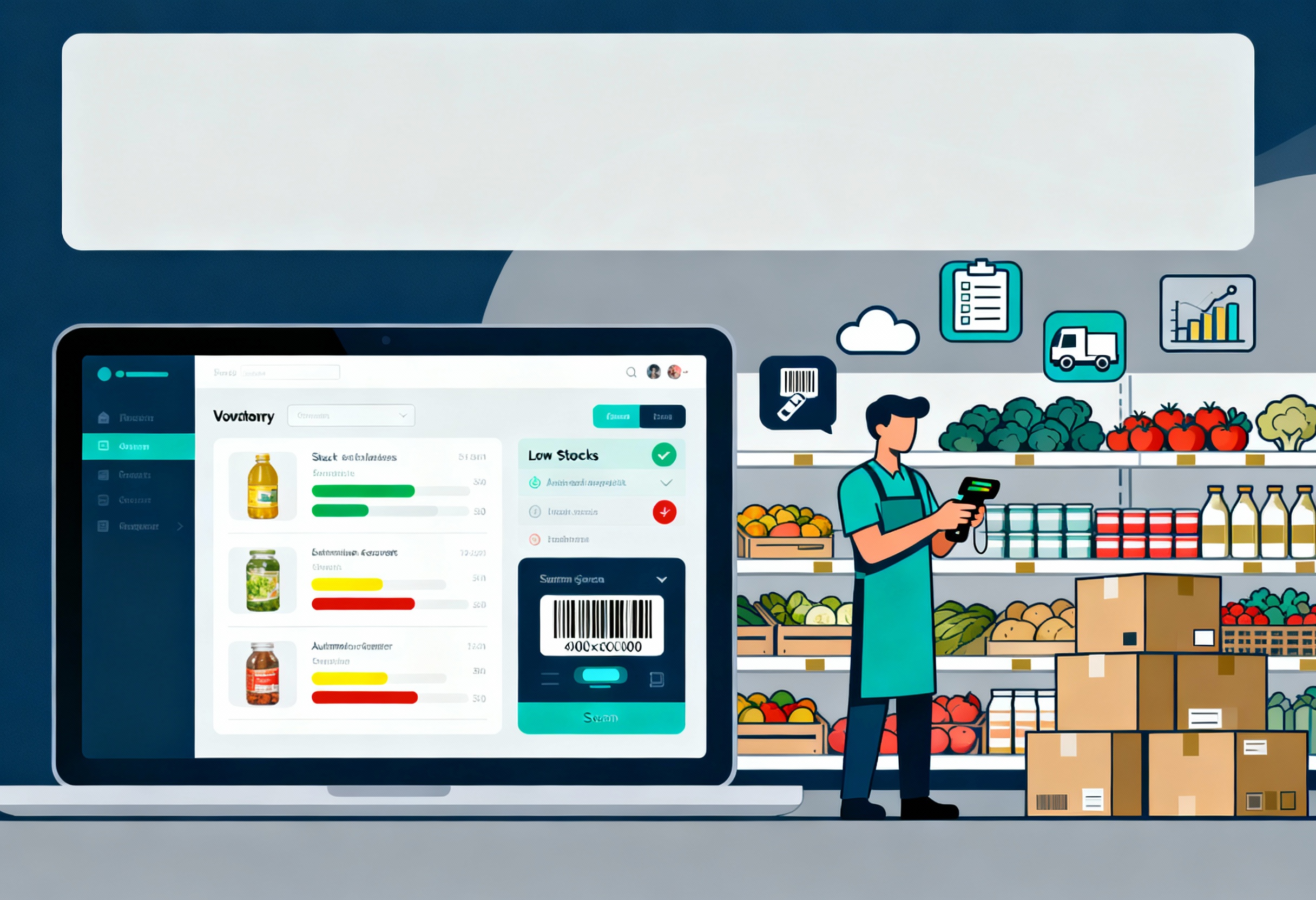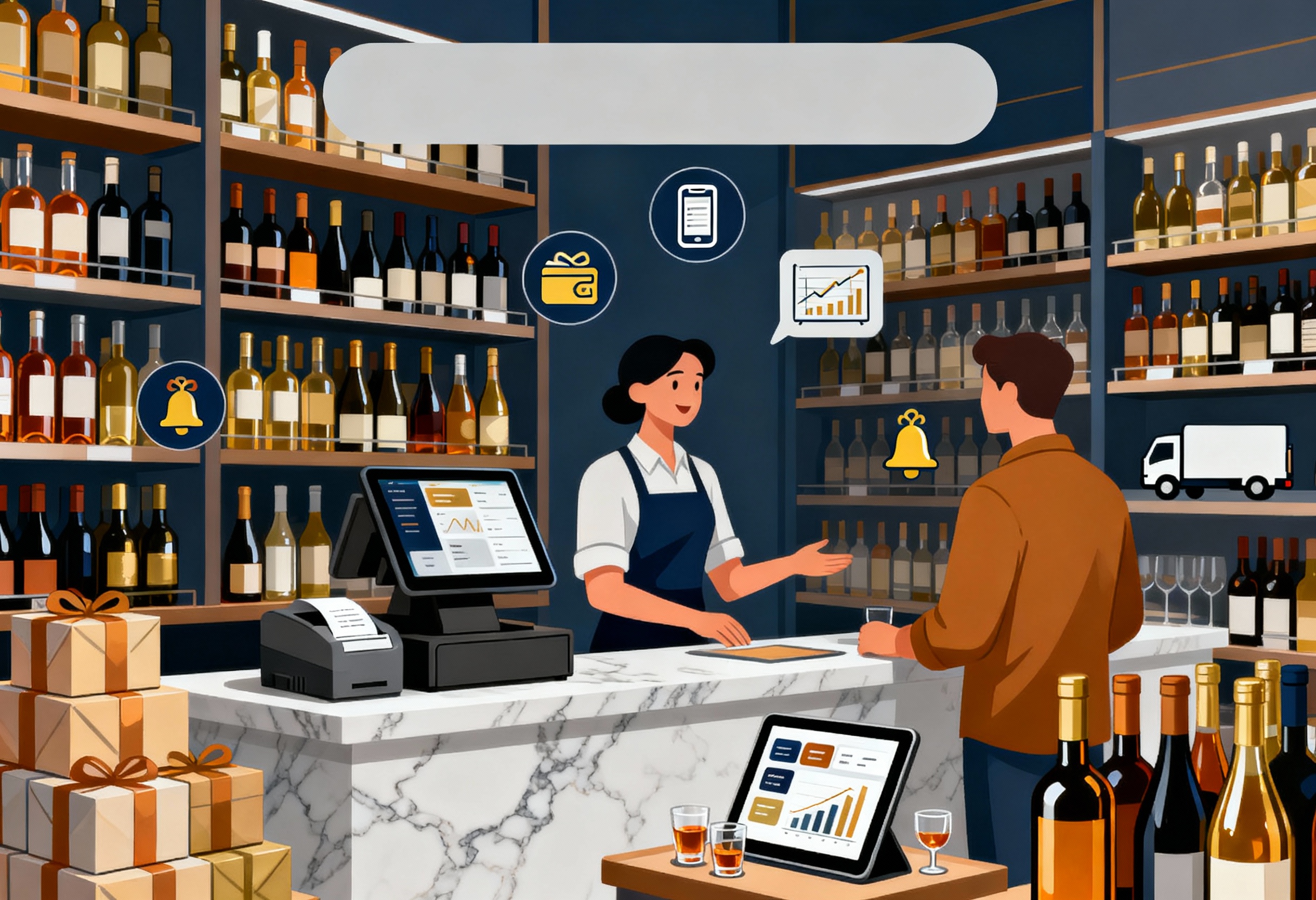As margins grow tighter and consumer expectations expand across in-store and digital channels, grocery retailers face mounting pressure to maintain availability, control waste, and connect operations with e-commerce. The online grocery market in the US is projected to more than double by 2031, which means retailers now require systems that do far more than simply record sales. They need platforms that bring clarity to fresh goods, expiration dates, vendor relationships, and shifting customer demand. This review from ConnectPOS highlights 5 grocery store inventory management software designed to help grocers in the US align daily operations with long-term growth strategies.
Highlights:
- Inventory management shapes cost control, customer loyalty, and compliance in U.S. grocery stores, directly influencing daily operations and long-term growth.
- The right software requires clear tracking, automation for reorders, expiry-date control, and integration with both POS and online sales channels.
Why Inventory Management Matters For Grocery Stores in US
Inventory management for US grocers extends far beyond counting products on shelves. It influences margins, shopper loyalty, regulatory compliance, and the ability to adapt to retail’s digital shift. Strong stock control supports both daily operations and long-term profitability, while weak oversight drains revenue and exposes businesses to compliance risks.
Key Points
- Cost impact: Overstock ties up capital in items that risk expiration, while shortages create missed sales and often force costly emergency purchases. US grocery chains must balance forecasting, replenishment, and vendor management to avoid waste and protect margins.
- Customer expectations: Shoppers in the US demand product availability and convenience. Stockouts frustrate them, while overcrowded or poorly managed shelves slow the shopping trip. Accurate inventory helps stores maintain the right mix of fresh goods and high-demand items, improving both satisfaction and loyalty.
- Regulatory compliance: The US grocery sector operates under strict oversight from bodies like the FDA and USDA. Accurate records on expiration dates, recalls, and labeling protect retailers from fines, lawsuits, and reputational damage.
- Digital transformation: As online grocery sales expand, retailers need systems that connect physical stores with e-commerce. Real-time inventory visibility, automated replenishment, and data-driven insights are no longer optional, they shape how grocers align supply chains, point-of-sale systems, and customer-facing platforms.
Key Features To Look For In Grocery Store Inventory Management Software
Grocery stores handle thousands of SKU, perishable items, and complex supply chains. Selecting inventory software requires focus on capabilities that track products accurately, connect data across locations, and support decisions affecting cost, compliance, and customer experience. An integrated grocery store inventory management software turns daily stock management into actionable insights that support the entire operation.
Key Points
- Real-time inventory tracking: Monitoring stock across shelves, storage, and online listings requires constant updates. Systems that capture transactions instantly prevent overstock and stockouts while giving managers a clear view of inventory flow.
- Barcode, QR, and RFID scanning: Scanning technology replaces manual counting, accelerates receiving and checkout processes, and reduces errors. Each product can be traced through its journey, from supplier to customer.
- Expiry date tracking and automated alerts: Perishable products demand close monitoring. Software that signals approaching expiration dates guides staff on rotation and disposal, limiting waste and supporting compliance with health and safety regulations.
- Multi-location management: Stores operating in several locations require stock synchronization. Centralized visibility allows transfers between branches, balances inventory levels, and prevents gaps in product availability.
- Demand forecasting and reporting: Historical sales data and seasonal patterns feed accurate projections. Forecasting tools help allocate stock efficiently, schedule orders, and plan promotions with minimal risk of surplus or shortage.
- POS integration and omnichannel sales sync: Connecting inventory to point-of-sale systems aligns online and offline sales. Orders are fulfilled accurately, stock levels reflect actual demand, and operational data informs pricing and procurement decisions.
- Mobile accessibility for staff devices: Staff can update inventory, check product availability, and manage tasks from anywhere in the store. Mobile access shortens response time and improves operational coordination.
- Vendor and purchase order management: Tracking suppliers, deliveries, and purchase orders strengthens supply chain reliability. Timely information on incoming stock reduces disruptions and supports budgeting and planning.
Advantages of Implementing Grocery Store Inventory Management Software
Implementing inventory management software in grocery stores changes the way retailers handle stock, purchasing, and sales visibility. It creates consistency across physical shelves and digital channels, giving managers better control over product flow and reducing common disruptions. The outcome is a stronger position to balance costs, customer expectations, and compliance demands in the U.S. market.
Stronger Control of Stock and Costs
Grocery stores typically face shrink due to spoilage, expiration, theft, or record errors. According to Datascan, fresh produce can lose 4–8% of sales to shrink, meat 3–5%, and dairy 2–4% due to expiry or improper storage. Inventory management software allows stores to track every item, expiry date, and storage location. With reliable data, stores cut down on unsellable goods and wasted stock.
Excess inventory also ties up cash flow. ZipDo Education Reports 2025 shows that grocery retailers using AI-powered demand forecasting recorded around 18% less food waste and 20–30% fewer stockouts. Lower overstock reduces storage costs and depreciation on perishable items, improving profit margins.
Better Shopping Experience
Stockouts directly affect customer loyalty and satisfaction. For example, when shoppers cannot find their usual cereal or favorite brand of milk, many will choose to buy from another store or switch to a different brand altogether. This is especially common among families with children who rely on specific items for daily meals. Grocery store inventory management software systems with real-time tracking and alerts help prevent these situations by ensuring shelves remain stocked.
On-shelf availability also influences how much customers spend. A grocery store that consistently has fresh fruit, vegetables, and daily staples available encourages shoppers to fill their carts with confidence. When customers know they can always rely on the store to have what they need, they are more likely to return regularly and recommend the store to friends or neighbors, building loyalty over time.
►►► Optimal solution set for businesses: Multi store POS, Next-gen POS, Inventory Management Software (MSI), Self Service, Automation, Backorders
Compliance and Risk Management
Grocery stores handle products that fall under strict food safety and labeling regulations. If expired items remain on shelves, the store risks penalties and reputational damage. Imagine a shopper finding spoiled dairy products still on display; not only would it prompt complaints, but it could also attract scrutiny from local inspectors. Inventory systems that track expiry dates and flag approaching deadlines allow staff to remove or discount products before they become a compliance issue.
Risk also extends to traceability. When suppliers issue recalls, stores must identify affected products quickly and pull them from circulation. A manual process can take hours or even days, leaving shoppers exposed. An automated grocery store inventory management software that records product details down to batch numbers helps staff isolate only the affected items, avoiding unnecessary waste while protecting both customers and the store’s reputation.
Integration with Digital Retail Trends
Modern grocery retail no longer separates physical shelves from digital channels. Shoppers expect to check product availability online, order through mobile apps, and decide between home delivery or click-and-collect. Salesforce’s Connected Shoppers Report found that more than half of retailers now provide these services, reflecting the shift toward hybrid shopping models. For consumers, the ability to move between digital and in-store touchpoints has become part of everyday grocery shopping.
Technology also reshapes how stores control waste and manage stockouts. Research on grocery supply chains shows that inventory record inaccuracies are common, especially for perishables. When audits are applied, store-wide sales can rise by around 11% because hidden gaps are corrected.
AI-driven systems strengthen this further by tracking shelf activity in real time, flagging out-of-stock risks, and connecting directly with logistics and POS platforms. The result is faster restocking, fewer compliance risks, and a smoother flow between digital ordering systems and physical shelves.
Best 5 Inventory Management Softwares For Grocery Stores In The US In 2025
The U.S. online grocery market, valued at USD 32.14 billion in 2023 and projected to reach USD 65.51 billion by 2031 at a CAGR of 9.31%, shows how quickly consumer behavior is shifting toward digital channels.

For grocery retailers, this expansion makes inventory management a decisive factor in balancing store shelves with online demand. The best 5 grocery store inventory management software solutions for 2025 are positioned to help grocers handle this dual challenge by combining real-time tracking, vendor integration, expiry controls, and omnichannel synchronization.
ConnectPOS
ConnectPOS is designed specifically for retail and can be custom for grocery and supermarket. It brings together the tools for compliance, daily sales, and customer engagement, while staying adaptable as the business scales.
Features
- Multi-store control: Manage inventory, pricing, and promotions across locations from a single hub.
- Dynamic stock management: Real-time tracking, expiry date monitoring, low-stock alerts, and automated order generation.
- Staff oversight: Role-based permissions, schedule monitoring, sales performance tracking, and smooth shift handovers.
- Flexible checkout: Options for self-checkout kiosks, mobile payments, contactless cards, and second screen displays.
- Customer engagement: Loyalty program integration, personalized promotions, detailed customer profiles including purchase history and dietary preferences.
- System integration: Works with accounting, ERP, CRM, and marketplace platforms for unified retail operations.
- Sustainability tools: Digital invoicing and e-receipts that simplify returns while cutting paper usage.
- Barcode and scale compatibility: Supports weighted items with barcode scales and PLU codes, ideal for produce, bulk goods, and deli counters.
- Batch and lot tracking: Track inventory by batch numbers or lot codes, useful for grocery stores dealing with traceability or regulatory compliance.
Pricing
- Standard – $49/register: Core business tools including eCommerce integration, real-time sync, unlimited payment gateways, reporting, and staff access control.
- Advanced – $79/register: Builds on Standard with quote/cart management, advanced checkout tools, loyalty support, and partial/gift card payments.
- Premium – $99/register: Adds stock transfer, stock-taking, multi-currency handling, omnichannel services (including click & collect), and priority support.
- Enterprise – Custom Quote: Tailored for large retailers with 100+ stores, including dedicated consultancy, full onboarding, API guidance, and industry-specific customization.
POS Nation
POS Nation is designed for small and mid-sized grocery operators in the United States who need more than just a checkout system. It functions as both a point-of-sale and inventory management platform, giving retailers one system to manage stock movement, sales data, and store operations. Instead of juggling separate tools, store managers can align purchasing, inventory visibility, and reporting within a single environment.
Features
- Real-time tracking: Stock levels are monitored continuously, allowing staff to act quickly when shelves begin to run low.
- Automatic stock updates: Every sale adjusts inventory records instantly, removing the need for manual reconciliation at the end of the day.
- Detailed reporting: Managers gain visibility into product performance, seasonal demand, and sales trends, which supports smarter purchasing decisions.
- Barcode scanning and SKU management: Scanning technology and structured SKU records cut down on entry errors and simplify daily operations.
- Multi-store management: Operators with more than one location can oversee all inventory from a single platform, maintaining consistency across sites.
Pricing
POS Nation does not follow a one-size-fits-all model. Instead, the company provides a build-and-price tool directly on its website, enabling grocery businesses to select the configuration that fits their operations.
Lightspeed POS
Lightspeed POS is a broad retail platform used across industries such as restaurants, retail stores, and golf courses. While not designed exclusively for supermarkets, its inventory management capabilities make it a practical choice for specialty grocers that need tighter control over products, vendor relationships, and purchasing. For smaller grocery operators with diverse product lines, Lightspeed brings both front-end sales and back-end stock management into one system.
Features
- Real-time inventory: Tracks product levels continuously across in-store shelves and online channels, giving managers a clear view of what is available at any moment.
- Centralized inventory control: Combines all stock data into one platform so purchasing and sales are aligned without separate tools or spreadsheets.
- Vendor management and purchase orders: Supports direct purchase order creation within the system while keeping vendor records organized for better supplier coordination.
- Inventory performance insights: Provides detailed reports on which items are moving quickly, which categories tie up capital, and how sales trends influence purchasing decisions.
Pricing
Lightspeed POS pricing starts with the Standard package at $119 per month. Costs vary depending on add-ons such as ecommerce, analytics, or payments, which allows specialty grocery operators to scale the platform according to store size and requirements.
IT Retail
IT Retail is a grocery store inventory management software which was built by a grocer for grocers, giving it a practical grounding in the day-to-day needs of supermarkets and specialty markets. Unlike generic POS platforms, it is tailored to the grocery sector’s complexity, where perishables, high transaction volumes, and evolving consumer demands all converge. The system combines front-end checkout with back-office stock control, making it a unified tool for owners and managers who need clarity across both operations.
Features
- Inventory management depth: The back-office system supports detailed item tracking, helping store managers control stock across thousands of SKUs, from fresh produce to packaged goods.
- Low-stock reports: Automatic alerts guide timely reordering, reducing the risk of empty shelves and keeping customer expectations met.
- E-commerce integration: Connections with major grocery ecommerce providers allow stores to open new revenue channels through online ordering and delivery without reworking existing operations.
- Transaction speed: Checkouts are designed for high-volume grocery environments, processing payments quickly across card, mobile, and contactless methods while keeping lines moving.
Pricing
IT Retail follows a customized pricing model. Each deployment is tailored after assessing store size, sales volume, hardware requirements, and service expectations.
KORONA POS
KORONA POS is a grocery store inventory management software designed for a broad set of industries, from grocery stores to quick-service restaurants and even large venues such as theme parks. For grocery operators, its value lies in balancing daily stock control with transaction processing while adding layers of loss prevention and vendor coordination. The system gives managers both operational oversight and practical tools for keeping store performance consistent.
Features
- Theft and loss prevention: User-specific access controls and permission settings help store owners limit exposure to shrinkage and internal theft.
- Mobile inventory management: Staff can perform stock counts and adjustments directly on mobile devices, speeding up tasks that would otherwise require back-office terminals.
- Vendor shipment notifications: Incoming shipments can be imported into the system, giving managers visibility into orders and improving accuracy in stock reconciliation.
- Product code flexibility: The system supports multiple product codes and barcode scanning, which simplifies labeling and tracking across varied product lines.
Pricing
KORONA POS pricing begins with the Core package at $59 per month. Additional costs apply for extended functions such as ecommerce or advanced reporting.
FAQ: Grocery Store Inventory Management Software
What distinguishes grocery store inventory management software from generic retail inventory tools?
Grocery-oriented software accounts for perishables, expiration dates, shrinkage from spoilage, and sales velocity that varies sharply (for example, produce versus canned goods). Generic tools often assume more stable inventory life cycles and less waste. Grocery software often includes expiry-tracking, batch/lot tracking, cold chain support, and real-time monitoring to handle fast product turnover and safety requirements.
What should smaller independent grocery stores consider when choosing such software?
Smaller grocers should prioritize features like mobile access (so staff can adjust inventory on the floor), expiry-alerts, simple POS integration, and flexible pricing. They may not need extremely complex forecasting or deeply customized workflows. Scalability matters: the solution should work well now but allow growth (e.g. adding locations or e-commerce) without necessitating a full platform replacement.
Why should I consider the Top 5 list for 2025?
This list highlights the most widely used solutions in the US, suitable for both independent stores and larger chains. Each software was evaluated on fresh goods management, e-commerce integration, scalability, and pricing flexibility. Referring to this list helps retailers choose proven systems instead of spending time testing tools that may not fit.
Conclusion
Grocery retail continues to evolve into a hybrid of shelf-based and digital-first shopping. The five platforms outlined in this article show how technology is being applied to challenges that define the industry: stockouts, compliance, perishable management, and omnichannel expectations. For decision-makers, selecting the right grocery store inventory management software is not just about software, but about setting the foundation for profitability and customer trust in the years ahead.
ConnectPOS brings its expertise to this conversation with solutions designed to unify point-of-sale and inventory management across grocery environments. If your store is ready to move beyond manual processes and fragmented systems, ConnectPOS can help you build the operational clarity and responsiveness needed for 2025 and beyond. Contact us now!
►►► Optimal solution set for businesses: Shopify POS, Magento POS, BigCommerce POS, WooCommerce POS, NetSuite POS, E-Commerce POS



